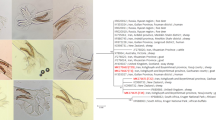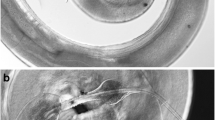Abstract
Polymerase chain reaction (PCR) and sequencing are useful for species identification of Trichinella spp., especially when their morphological characteristics useful for identifying taxa are lacking. In the present study, nine Trichinella isolates from different provinces in mainland China were identified by the PCR-based method using the 5S ribosomal DNA intergene spacer region (5S ISR) and the mitochondrial large subunit ribosomal DNA genes as molecular markers. The results indicated that eight isolates originating from domestic pigs and one isolate originating from civet cat (Paguma larvata) showed identical DNA banding pattern to Trichinella spiralis. Sequence analysis of the 5S ISR gene further confirmed that the nine Trichinella isolates were T. spiralis and revealed the intraspecies genetic variation within T. spiralis.



Similar content being viewed by others
References
Borsuk P, Moskwa B, Pastusiak K, Cabaj W (2003) Molecular identification of Trichinella spiralis and Trichinella britovi by diagnostic multiprimer large mitochondrial rRNA amplification. Parasitol Res 91:374–377
Cui J, Wang ZQ, Xu BL (2011) The epidemiology of human trichinellosis in China during 2004–2009. Acta Trop 118:1–5
de Bruyne A, Year H, Le Guerhier F, Boireau P, Dupouy-Camet J (2005) Simple species identification of Trichinella isolates by amplification and sequencing of the 5S ribosomal DNA intergenic spacer region. Vet Parasitol 132:57–61
Fu BQ, Liu MY, Yao CY, Li WH, Li YG, Wang YH, Wu XP, Zhang DL, Cai XP, Blaga R, Boireau P (2009) Species identification of Trichinella isolates from China. Vet Parasitol 159:214–217
Gasser RB, Zhu XQ, Monti JR, Dou L, Cai X, Pozio E (1998) PCR-SSCP of rDNA for the identification of Trichinella isolates from mainland China. Mol Cell Probes 12:27–34
Jiang P, Mao FR, Cui J, Li F, Zhang X, Wang L, Wang ZQ (2009) PCR-SSCP analysis on partial mitochondrial cytochrome c-oxidase subunit I (COX I) genes of different Trichinella spiralis isolates. Zhengzhou Univ J Med Sci 44:506–509
Kanai Y, Nonaka N, Katakura K, Oku Y (2006) Trichinella nativa and Trichinella T9 in the Hokkaido Island, Japan. Parasitol Int 55:313–315
Krivokapich SJ, Prous CL, Gatti GM, Confalonieri V, Molina V, Matarasso H, Guarnera E (2008) Molecular evidence for a novel encapsulated genotype of Trichinella from Patagonia, Argentina. Vet Parasitol 156:234–240
La Rosa G, Pozio E, Rossi P, Murrell KD (1992) Allozyme analysis of Trichinella isolates from various host species and geographical regions. J Parasitol 78:641–646
La Rosa G, Marucci G, Pozio E (2003) Biochemical analysis of encapsulated and non-encapsulated species of Trichinella (Nematoda, Trichinellidae) from cold- and warm-blooded animals reveals a high genetic divergence in the genus. Parasitol Res 91:462–466
Li F, Cui J, Wang ZQ, Jiang P (2010) Factors affecting the sensitivity of artificial digestion and its optimization for inspection of Trichinella spiralis in meat. Foodborne Pathog Dis 7:879–885
Liu MY, Zhu XP, Xu KC, Lu Q, Boireau P (2001) Biological and genetic characteristics of two Trichinella isolates in China; comparison with European species. Parasite 8:S34–S38
Lo YC, Hung CC, Lai CS, Wu Z, Nagano I, Maeda T, Takahashi Y, Chiu CH, Shyong Jiang DD (2009) Human trichinosis after consumption of soft-shelled turtles, Taiwan. Emerg Infect Dis 15:2056–2058
Marucci G, La Rosa G, Pozio E (2010) Incorrect sequencing and taxon misidentification: an example in the Trichinella genus. J Helminthol 84:336–339
Murrell KD, Lichtenfels RJ, Zarlenga DS, Pozio E (2000) The systematics of the genus Trichinella with a key to species. Vet Parasitol 93:293–307
Pan YB, Burner DM, Legendre BL (2000) An assessment of the phylogenetic relationship among sugarcane and related taxa based on the nucleotide sequence of 5S rRNA intergenic spacers. Genetica 108:285–295
Pozio E (2000) Factors affecting the flow among domestic, synanthropic and sylvatic cycles of Trichinella. Vet Parasitol 93:241–262
Pozio E, Murrell KD (2006) Systematics and epidemiology of Trichinella. Adv Parasitol 63:367–439
Pozio E, Foggin CM, Marucci G, La Rosa G, Sacchi L, Corona S, Rossi P, Mukaratirwa S (2002) Trichinella zimbabwensis n. sp. (Nematoda), a new non-encapsulated species from crocodiles (Crocodylus niloticus) in Zimbabwe also infecting mammals. Int J Parasitol 32:1787–1799
Rombout YB, Bosch S, van der Giessen JW (2001) Detection and identification of eight Trichinella genotypes by reverse line blot hybridization. J Clin Microbiol 39:642–646
Saitou N, Nei M (1987) The neighbor-joining method: a new method for reconstructing phylogenetic trees. Mol Biol Evol 4:406–425
Tamura K, Dudley J, Nei M, Kumar S (2007) MEGA4: molecular evolutionary genetics analysis (MEGA) software version 4.0. Mol Biol Evol 24:1596–1599
Thompson JD, Gibson TJ, Plewniak F, Jeanmougin F, Higgins DG (1997) The Clustal X windows interface: flexible strategies for multiple sequence alignment aided by quality analysis tools. Nucleic Acids Res 25:4876–4882
van der Giessen JW, Fonville M, Briels I, Pozio E (2005) Phylogenetic analysis of encapsulated and non-encapsulated Trichinella species by studying the 5S rDNA tandemly repeated intergenic region. Vet Parasitol 132:51–55
Wang ZQ, Cui J (2001) Epidemiology of human trichinellosis in China during 1964–1999. Parasite 8:S63–S66
Wang ZQ, Cui J, Xu BL (2006) The epidemiology of human trichinellosis in China during 2000–2003. Acta Trop 97:247–251
Wang ZQ, Cui J, Shen LJ (2007) The epidemiology of animal trichinellosis in China. Vet J 173:391–398
Zarlenga DS, Rosenthal BM, La Rosa G, Pozio E, Hoberg EP (2006) Post-Miocene expansion, colonization, and host switching drove speciation among extant nematodes of the archaic genus Trichinella. Proc Natl Acad Sci USA 103:7354–7359
Acknowledgments
This work was supported by the National Basic Research Program of China (no. 2010CB530000), the National Natural Science Foundation of China (no. 30972492), and the Major Public Research Project of Henan Province (no. 2008-145).
Conflict of interest
There are no conflicts of interest.
Author information
Authors and Affiliations
Corresponding authors
Rights and permissions
About this article
Cite this article
Wang, Z.Q., Li, L.Z., Jiang, P. et al. Molecular identification and phylogenetic analysis of Trichinella isolates from different provinces in mainland China. Parasitol Res 110, 753–757 (2012). https://doi.org/10.1007/s00436-011-2549-3
Received:
Accepted:
Published:
Issue Date:
DOI: https://doi.org/10.1007/s00436-011-2549-3




